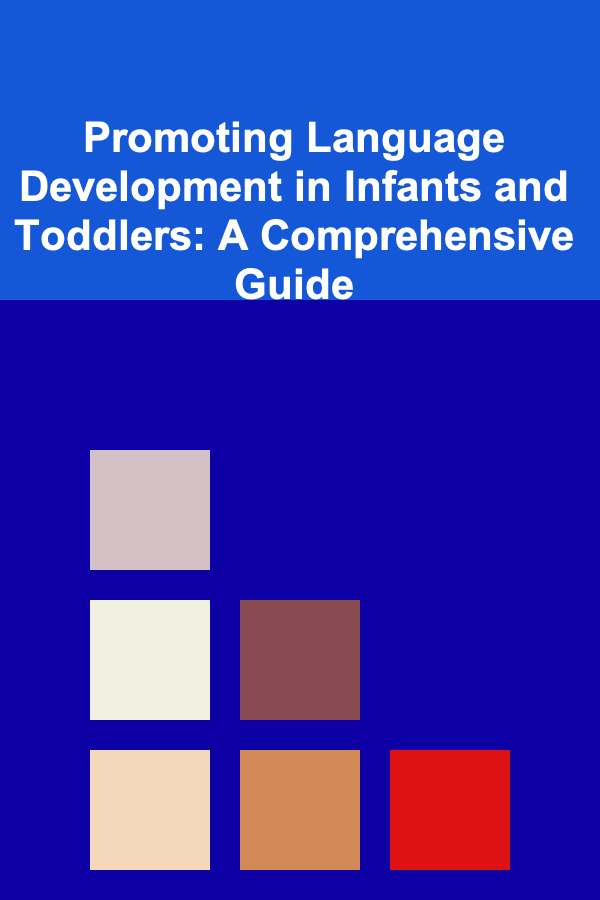
Promoting Language Development in Infants and Toddlers: A Comprehensive Guide
ebook include PDF & Audio bundle (Micro Guide)
$12.99$5.99
Limited Time Offer! Order within the next:

Language development in infants and toddlers is a complex and fascinating process, laying the foundation for future communication, literacy, and cognitive skills. These early years, from birth to around three years old, represent a critical period for language acquisition. A child's environment and the interactions they have with caregivers significantly influence their ability to learn and use language effectively. Creating a rich language environment, filled with opportunities for communication and engagement, is paramount. This article delves deeply into the strategies and techniques parents, educators, and caregivers can utilize to promote optimal language development in infants and toddlers.
Understanding the Stages of Language Development
Before diving into specific strategies, it's crucial to understand the typical stages of language development. While every child develops at their own pace, understanding these milestones provides a general framework for tracking progress and identifying potential delays. Knowing these stages helps to tailor interventions and support to the child's current needs.
Infancy (0-12 Months)
- Prelinguistic Stage (0-6 months): This stage is characterized by non-verbal communication. Babies communicate through crying, cooing, gurgling, and facial expressions. They begin to recognize their parent's voice and may even turn their head towards sounds. Pay close attention to their cues and respond to their needs promptly and consistently. This builds trust and a foundation for future communication. They are also actively absorbing information about the sounds and rhythms of their native language.
- Babbling Stage (6-12 months): Babbling marks the emergence of consonant-vowel sounds (e.g., "ba," "da," "ga"). Around 9-10 months, babies begin to produce reduplicated babbling (e.g., "mama," "dada"). This is not necessarily meaningful, but it's a crucial step towards forming words. Encourage babbling by imitating the sounds your baby makes and responding with enthusiasm. Introducing simple sign language during this period can also be beneficial.
Toddlerhood (12-36 Months)
- One-Word Stage (12-18 months): Toddlers start using single words to communicate their needs and wants. These words often represent familiar objects, people, or actions (e.g., "ball," "mama," "eat"). The meaning of these words is often understood within context and accompanied by gestures. Expand on their single words by providing labels and descriptions. For example, if your toddler says "ball," you could respond with "Yes, that's a red ball!"
- Two-Word Stage (18-24 months): Toddlers begin combining two words to form simple phrases (e.g., "more juice," "daddy go"). These early sentences are typically telegraphic, meaning they lack grammatical elements like articles and prepositions. Model correct grammar and expand on their phrases. If your toddler says "more juice," you could say "You want more juice? Here's more juice in your cup."
- Early Multi-Word Stage (24-36 months): Toddlers start using longer and more complex sentences. Their vocabulary expands rapidly, and they begin to use grammatical markers like plural endings and verb tenses. They can follow simple instructions and ask questions. Engage in conversations with your toddler, ask open-ended questions, and encourage them to tell stories.
Creating a Language-Rich Environment
A language-rich environment provides infants and toddlers with ample opportunities to hear, interact with, and practice language. This doesn't necessarily mean a sterile or overly academic environment. It simply means being intentional about incorporating language into everyday activities and routines.
1. Talk, Talk, Talk!
The most crucial element of a language-rich environment is simply talking to your child. Even before they can understand words, they are absorbing the sounds, rhythms, and intonations of language. Talk about everything you're doing, seeing, and thinking. Narrate your daily activities, describe objects, and express your feelings. Don't underestimate the power of simple, everyday conversation.
- Narrate your day: "Now I'm getting the bread out of the cupboard. We're going to make a sandwich for lunch."
- Describe what you see: "Look at that big, yellow school bus! It's going down the street."
- Express your feelings: "I'm so happy to see you! I missed you today."
2. Reading Aloud
Reading aloud is one of the most effective ways to promote language development. It exposes children to a wide range of vocabulary, sentence structures, and story patterns. Choose age-appropriate books with colorful illustrations and engaging storylines. Make reading a regular part of your daily routine.
- Choose age-appropriate books: For infants, select board books with simple images and textures. For toddlers, choose books with repetitive phrases and interactive elements.
- Make it interactive: Point to the pictures, ask questions about the story, and encourage your child to participate.
- Read with enthusiasm: Use different voices for different characters and bring the story to life.
3. Singing Songs and Rhymes
Singing songs and reciting rhymes helps children develop phonological awareness, which is the ability to recognize and manipulate the sounds of language. It also introduces them to rhythm, melody, and rhyme, which are important for literacy development. Sing familiar songs like "Twinkle, Twinkle, Little Star" and "The Itsy Bitsy Spider." Make up your own songs about everyday activities.
- Use actions and gestures: Combine singing with actions to make it more engaging.
- Repeat songs frequently: Repetition helps children learn the words and melodies.
- Introduce new songs gradually: Don't overwhelm your child with too many new songs at once.
4. Play and Pretend
Play is an essential part of a child's development, and it provides ample opportunities for language learning. Engage in pretend play with your child, using toys, props, and your imagination. Create scenarios and act out different roles. Encourage your child to talk and interact during play.
- Use open-ended toys: Toys like blocks, dolls, and cars can be used in a variety of ways, encouraging creativity and language use.
- Create a dramatic play area: Set up a pretend kitchen, doctor's office, or store.
- Follow your child's lead: Let your child direct the play and follow their interests.
5. Use Descriptive Language
When talking to your child, use descriptive language to help them learn new words and concepts. Describe the size, shape, color, and texture of objects. Use comparative terms like "bigger," "smaller," "taller," and "shorter." Explain how things work and why things happen.
- Describe objects in detail: "Look at that fluffy white cloud. It's shaped like a sheep!"
- Use comparative terms: "This spoon is bigger than that spoon."
- Explain cause and effect: "If you push the button, the toy will make a noise."
6. Expand and Extend
When your child speaks, expand and extend their utterances. This means adding to their words or phrases to make them more grammatically correct and to provide additional information. This helps them learn new vocabulary and sentence structures.
- Child: "Dog bark."
- Parent: "Yes, the dog is barking. He's barking loudly at the mailman."
7. Ask Open-Ended Questions
Instead of asking questions that can be answered with a simple "yes" or "no," ask open-ended questions that encourage your child to think and talk. These types of questions promote critical thinking and language development.
- Instead of: "Is that a car?"
- Ask: "What is that?" or "What color is the car?" or "Where is the car going?"
8. Limit Screen Time
While some educational programs can be beneficial, excessive screen time can hinder language development. Children learn best through real-life interactions and hands-on experiences. Limit screen time and prioritize activities that promote language learning, such as reading, playing, and talking.
- Follow age-appropriate guidelines: The American Academy of Pediatrics recommends limiting screen time for children aged 2-5 to one hour per day of high-quality programming.
- Choose educational programs carefully: Look for programs that are interactive and that encourage children to talk and participate.
- Engage with your child during screen time: Watch programs with your child and talk about what you're seeing.
Addressing Potential Language Delays
While it's important to remember that every child develops at their own pace, it's also important to be aware of potential language delays and to seek professional help if you have concerns. Early intervention can make a significant difference in a child's language development.
Signs of a Potential Language Delay
- By 12 months: Not babbling or making any attempts to communicate.
- By 18 months: Not using at least 10 words.
- By 24 months: Not combining two words to form simple phrases.
- By 30 months: Not understanding simple directions or following simple routines.
- By 36 months: Not speaking in short sentences or having difficulty being understood by familiar adults.
Seeking Professional Help
If you are concerned about your child's language development, talk to your pediatrician. They can assess your child's language skills and recommend further evaluation if necessary. Speech-language pathologists are trained professionals who can diagnose and treat language delays and disorders. Early intervention services are often available for young children with developmental delays.
Strategies for Children with Language Delays
For children with language delays, a speech-language pathologist can provide individualized therapy and support. Here are some general strategies that can be helpful:
- Increase the frequency of interactions: Spend more time talking, reading, and playing with your child.
- Simplify your language: Use shorter sentences and simpler vocabulary.
- Use visual supports: Pictures, gestures, and sign language can help children understand and communicate.
- Create a predictable routine: Children with language delays often benefit from predictable routines and schedules.
- Reinforce communication attempts: Praise and encourage your child's attempts to communicate, even if they are not perfect.
The Role of Caregivers and Educators
Parents are not the only ones who play a crucial role in promoting language development. Caregivers and educators in childcare centers and preschools also have a significant impact. Consistency between home and care settings is extremely beneficial.
Communication with Parents
Open communication between caregivers/educators and parents is essential. Sharing information about a child's progress, interests, and challenges helps ensure a coordinated approach to language development. Daily or weekly updates, parent-teacher conferences, and shared activities can facilitate this communication.
Structured Language Activities
Caregivers and educators can incorporate structured language activities into their daily routines. This includes storytime, circle time (where children engage in songs, rhymes, and calendar discussions), and small group activities focused on specific language skills.
Individualized Attention
Recognizing that each child develops at their own pace, caregivers and educators should provide individualized attention to support each child's unique language needs. This may involve providing extra support to children who are struggling or offering more challenging activities to those who are advanced.
Creating a Supportive and Inclusive Environment
A supportive and inclusive environment is crucial for language development. Children should feel comfortable taking risks, making mistakes, and expressing themselves. Caregivers and educators should create a classroom or childcare setting that celebrates diversity and respects individual differences.
Specific Activities and Games to Encourage Language Development
Here are some specific activities and games that parents and caregivers can use to promote language development:
Sensory Bins
Fill a bin with various materials like rice, beans, water, or sand, and add small toys or objects. This encourages descriptive language as children describe the textures and objects they find. For example, "The rice feels gritty!" or "I found a smooth, blue marble!"
Puppet Shows
Use puppets to act out stories or create new ones. This encourages imaginative play and provides opportunities for children to practice dialogue and narration.
Picture Cards
Use picture cards to teach new vocabulary. Show the card, say the word, and ask the child to repeat it. You can also play games like matching or memory with picture cards.
Treasure Hunts
Hide objects around the room and give the child clues to find them. This encourages following directions and using descriptive language. "Look under the red pillow" or "The treasure is near something that goes 'meow.'"
Cooking Together
Cooking is a great way to introduce new vocabulary related to food, ingredients, and cooking processes. It also encourages following directions and sequencing.
Nature Walks
Take a walk in nature and talk about the things you see, hear, and smell. This provides opportunities to learn new words related to plants, animals, and the environment.
The Importance of Positive Reinforcement
Positive reinforcement is a powerful tool for encouraging language development. Praise and encouragement can motivate children to keep practicing and learning. Provide specific feedback on their efforts, rather than just saying "good job." For example, "I like how you used the word 'gigantic' to describe the elephant!"
Addressing Bilingualism and Multilingualism
In today's globalized world, many children are exposed to multiple languages from a young age. Bilingualism and multilingualism have been shown to have cognitive benefits, including improved attention and problem-solving skills.
Encouraging Exposure to Multiple Languages
Encourage exposure to multiple languages through books, music, movies, and conversations with native speakers. If possible, expose children to both languages consistently and regularly.
One Parent, One Language (OPOL)
The One Parent, One Language (OPOL) method is a common approach where each parent speaks a different language to the child. This helps children associate each language with a specific person.
Creating Opportunities for Language Use
Create opportunities for children to use each language in meaningful contexts. This may involve visiting relatives who speak a different language or enrolling in language classes.
Conclusion
Promoting language development in infants and toddlers is a multifaceted process that requires a dedicated and responsive approach. By creating a language-rich environment, engaging in meaningful interactions, addressing potential delays promptly, and recognizing the crucial roles of parents, caregivers, and educators, we can empower children to develop strong language skills that will serve them well throughout their lives. The investment in these early years pays dividends in future academic success, social-emotional well-being, and overall life opportunities. Remember that patience, consistency, and genuine engagement are key to unlocking a child's full linguistic potential. Embrace the joy of watching a child's language blossom, and celebrate every milestone along the way.

How to Remove Stains from Carpets: A Step-by-Step Guide
Read More
User Interface Designer's Handbook: From Wireframes to Stunning Interfaces
Read More
How to Master Basic Stir-Frying
Read More
Identifying Birds by Wingspan: A Comprehensive Guide
Read More
Exploring the Deserts of Namibia: A Comprehensive Guide
Read More
How to Prepare for Seasickness: A Cruise Checklist
Read MoreOther Products

How to Remove Stains from Carpets: A Step-by-Step Guide
Read More
User Interface Designer's Handbook: From Wireframes to Stunning Interfaces
Read More
How to Master Basic Stir-Frying
Read More
Identifying Birds by Wingspan: A Comprehensive Guide
Read More
Exploring the Deserts of Namibia: A Comprehensive Guide
Read More